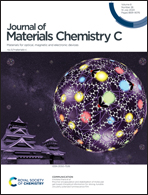Benzo[4,5]thieno-S,S-dioxide-[3,2-b]benzofurans: synthesis, properties and application in electroluminescent devices†
Abstract
The first mixed thieno-S,S-dioxide-furan acenes (BTOBFs) were constructed by simple oxidation of benzo[4,5]thieno-[3,2-b]benzofurans (BTBFs). After oxidation, the absorption and emission peaks of the compounds undergo a significant red shift, and fluorescence quantum yields (Φf = 0.23–0.90) are increased several to several tens of times thanks to the more rigid and more π-extended molecular backbone as well as significant intramolecular charge transfer. F-BTOBF and F,Cl-BTOBF displayed somewhat low device performance with external quantum efficiency (EQE) of 0.72–0.78% yet desirable blue emission. However, when we introduce strong electron-donating groups such as carbazolyl or triphenylamino group into BTOBFs to further tune the electronic properties, the resulting compounds 2-NPhCz-BTOBF and 2-TPA-BTOBF exhibit not only much red shift in absorption and fluorescence, but also significant improvement in hole mobility. As a result, these two compounds displayed much better device performance with respectable EQEs of 5.82–6.49%, low turn-on voltage less than 3 V and lower efficiency roll-off. Therefore, for the first time, this work reports the huge potential of mixed thieno-S,S-dioxide-furan acenes as blue to green emitters for high-performance OLEDs.
![Graphical abstract: Benzo[4,5]thieno-S,S-dioxide-[3,2-b]benzofurans: synthesis, properties and application in electroluminescent devices](/en/Image/Get?imageInfo.ImageType=GA&imageInfo.ImageIdentifier.ManuscriptID=C9TC06790F&imageInfo.ImageIdentifier.Year=2020)


 Please wait while we load your content...
Please wait while we load your content...